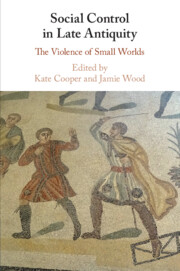Book contents
- Social Control in Late Antiquity
- Social Control in Late Antiquity
- Copyright page
- Contents
- Contributors
- Preface and Acknowledgements
- Abbreviations
- Introduction
- Part I Women and Children First
- Part II ‘Slaves, be subject to your masters’
- Part III Knowledge, Power, and Symbolic Violence
- Part IV Vulnerability and Power
- Bibliography
- Index
Introduction
The Violence of Small Worlds: Rethinking Small-Scale Social Control in Late Antiquity
Published online by Cambridge University Press: 18 September 2020
- Social Control in Late Antiquity
- Social Control in Late Antiquity
- Copyright page
- Contents
- Contributors
- Preface and Acknowledgements
- Abbreviations
- Introduction
- Part I Women and Children First
- Part II ‘Slaves, be subject to your masters’
- Part III Knowledge, Power, and Symbolic Violence
- Part IV Vulnerability and Power
- Bibliography
- Index
Summary
Conflict and Social Control in Late Antiquity examines how the cultivation and application of violence across a range of ‘small worlds’ contributed to the making of society in the late Roman period. From households and families to schoolrooms and monasteries, chapters address the different roles that violence played in maintaining and reinforcing the social order, even during a period of intense religious and political change. Elites adopted a range of approaches – formal and informal, legal and illegal, private and public – to keep subordinates in their place. Especially important were the efforts of social elites to inculcate in their followers the idea that the social order was natural rather than contingent, and therefore should not be challenged but rather perpetuated. Chapters focus on written sources from the fourth and fifth centuries, mainly on Christian authors. Collectively, they show that rather than seeking to transform the fortunes of those who were most vulnerable in society (slaves, women, children), such writers drew creatively on pre-existing discursive traditions, in the process reproducing and (occasionally) attempting to mitigate the plight of the downtrodden.
Keywords
- Type
- Chapter
- Information
- Social Control in Late AntiquityThe Violence of Small Worlds, pp. 1 - 12Publisher: Cambridge University PressPrint publication year: 2020
- 1
- Cited by

